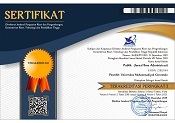Strategy Analysis of Regional Tourism Development: Case Study of Restaurant in Barru District
Abstract
This study aims to describe the strategies used in increasing restaurant guest visits in Barru Regency. This research uses a quantitative descriptive approach. Based on the results of the study, it was found that the 4P marketing mix strategy (Price, Promotion, Place and position) was applied to the Barru district restaurant to increase guest visits, this proved effective in attracting guests to visit the restaurant. product, price, place, promotion, have shown conformity with the segmentation, targeting and positioning expected by the restaurant. For example, the products offered are varied and use quality raw materials in accordance with the positioning that the company wants to achieve as the only restaurant that uses healthy raw chicken and seafood. Apart from that the price, physical evidence and promotion are also in accordance with the targeting of young people and families, because the prices offered are still quite affordable, the place is also unique and is promoted through online media.
Keywords
Full Text:
PDFReferences
Adams, R. (2005). Fast food, obesity and tort reform: an examination of industry responsibility for public health. Business and Society Review, 110(3), 297-320.
Ariffin, H.F., Bibon, M.F., & Abdullah, R.P.S. R, (2011). Restaurant's atmospheric elements: what the customer wants. Journal of Asian Behavioural Studies, 1(2), 33-43.
Aryanti, D., Hudoyo, A., & Kaymir, E, (2013). Analisis tingkat pelayanan restoran terhadap kepuasan pelanggan: studi kasus pada dua restoran di kompleks pertokoan way halim permai kota Bandar Lampung. Journal of Agribusiness Science, 1(2), 118-125.
Babin, B.J., Lee, Y., Kim, E., Griffin, M, (2005). Modeling consumer satisfaction and word-of-mouth: restaurant patronage in Korea. Journal of Services Marketing. 19(3), 133-139.
BPS. (2017). Kabupaten Barru Dalam Angka Tahun 2017. Badan Pusat Statistik.
Goyal, A. & Singh, N. P, (2007). Consumer perception about fast food in India: an exploratory study. British Food Journal, 109(2), 182-195
Kementerian Pariwisata. (2014). Perkembangan Usaha Restoran/ Rumah Makan Berskala Menengah dan Besar Menurut Provinsi. [Online] Tersedia di: http:// www.kemenpar.go.id/asp/ringkasan.asp?c=114 [Diakses 2 Februari 2019].
Malik, S.A., Jaswal, L.H., Malik, S.A. & Awan, T.M, (2013). Measuring service quality perceptions of the customers of restaurant in Pakistan. International Journal for Quality Research, 7(2), 187-200.
Nasir, M. (2005). Metodelogi Penelitian. Jakarta: Ghalia Indonesia.
Nitisemito, A. (1995). Manajemen Pemasaran. Jakarta: Ghalia Indonesia.
Ryu, K., & Han, H. (2010). Influence on the quality of food, service, and physical environment on customer satisfaction and behavioral intention in quick-casual restaurants: moderating role of perceived price. Journal of Hospitalityand Tourism Research. 34(3), 310-329.
Saidani, B., Rachman, M. A. & Rizan, M, (2013). Pengaruh kualitas produk dan desain produk terhadap keputusan pembelian sepatu olahraga futsal adidas di wilayah Jakarta Timur. Jurnal Riset Manajemen Sains Indonesia, 4(2), 201-217.
Syahrial, S., & Badollahi, M. Z. (2020). Development of a Community-Based Marine Tourism Attraction in the Samboang Beach in Bulukumba Regency. Journal La Bisecoman, 1(2), 1-9.
Yusoff, W. Z. W., Ismail, M. & Ali, A.S. (2010). Understanding the services provider perspective towards better service quality in local authorities. Journal of Facilities Management, 8(3), 226-230.
Article metrics
Refbacks
- There are currently no refbacks.
Copyright (c) 2020 Publik (Jurnal Ilmu Administrasi)

This work is licensed under a Creative Commons Attribution-ShareAlike 4.0 International License.

Publik (Jurnal Ilmu Administrasi) is licensed under a Creative Commons Attribution-ShareAlike 4.0 International License.










